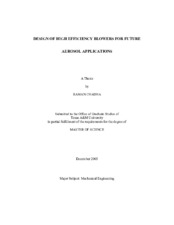| dc.description.abstract | High efficiency air blowers to meet future portable aerosol sampling applications were
designed, fabricated, and evaluated. A Centrifugal blower was designed to achieve a flow
rate of 100 L/min (1.67 x 10^-3 m^3/s) and a pressure rise of WC " 4 (1000 PA). Commercial
computational fluid dynamics (CFD) software, FLUENT 6.1.22, was used extensively
throughout the entire design cycle. The machine, Reynolds number (Re) , was around 10^5
suggesting a turbulent flow field. Renormalization Group (RNG) κ−ε turbulent model
was used for FLUENT simulations. An existing design was scaled down to meet the
design needs. Characteristic curves showing static pressure rise as a function of flow rate
through the impeller were generated using FLUENT and these were validated through
experiments.
Experimentally measured efficiency (ηEXP) for the base-design was around 10%. This
was attributed to the low efficiency of the D.C. motor used. CFD simulations, using the
κ−ε turbulent model and standard wall function approach, over-predicted the pressure
rise values and the percentage error was large.
Enhanced wall function under-predicted the pressure rise but gave better agreement (less
than 6% error) with experimental results. CFD predicted a blower scaled 70% in planar
direction (XZ) and 28% in axial direction (Y) and running at 19200 rpm
(70xz_28y@19.2k) as the most appropriate choice. The pressure rise is 1021 Pa at the design flow rate of 100 L/min. FLUENT predicts an efficiency value based on static head
(ηFLU) as 53.3%. Efficiency value based on measured static pressure rise value and the
electrical energy input to the motor (ηEXP) is 27.4%. This is almost a 2X improvement
over the value that one gets with the hand held vacuum system blower. | en |


